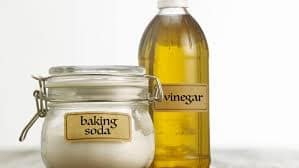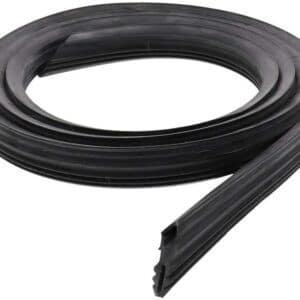How to Get Black Mold Out of Dishwasher
Dishwashers are our kitchen friends! Particularly if you're into cooking and baking regularly, dishwashers take the drudgery out of cleaning up afterwards.

Like any other household appliance, dishwashers come with their own set of challenges – both mechanical, and in this case, fungal too! The thought of having a mold invasion in your trusty dishwashing friend isn't pleasant but it's a modern day reality, with some studies showing over 60% of household dishwashers carrying a form of mold.
In this article we're going to look at mold itself, it's relationship with your dishwasher, and what you can do about getting rid of it!
To start off with, let's arm ourselves with information, because knowledge is power in the fight for clean dishes!
What Is Mold?
Simply put, mold is a type of fungus. It grows in multicellular filaments (or strings) called hyphae. It's those fuzzy and thread like bits that give mold its weird and wonderful looks, and because there are many different types of fungi, it can take on a number of forms. Below are some examples of mold growing in petri dishes. To be fair, they're not unattractive.

Mold grows from spores that float around in the air, so no home is truly immune from its presence. Although molds cause household damage and food spoilage, they do good stuff too. In fact, not only are molds important for making tasty things like cheese, but they are also used to make the antibiotics that fight off disease when we're ill.
How do you know if you have a moldy dishwasher?
Often, you may have mold in your dishwasher and not even be aware of it – many forms of mold are tiny and some kinds can be colorless, so they can be very hard to spot. To be on the safe side, it's best to assume that you do have mold in some crevices of your dishwasher – that may not even be obvious to the naked eye.
If your dishwasher smells of a 'mildewy' or musty odor, that's a bad sign.
The problem is, mold spores can survive without growing or being visible, they'll just sit around waiting for the right conditions to grow and spread. For mold spores the right conditions are humid, warm and moist – just like the inside of your dishwasher! So, regular anti – mold measures just make sense.
Can mold make you sick?

Yes, mold in your dishwasher can make you sick, and here are some health problems it causes:
- Mold can cause fungal allergies to start
- Respiratory Infections
- Breathing Problems – like asthma
- C.O.P.D – Chronic Obstructive Pulmonary Disorder
- Irritating symptoms like sneezing, runny nose and throat inflammation
- Skin Irritation and Rashes
- The Aspergillus fungus has been found to cause Cystic Fibrosis
Some health problems caused by exposure to mold can be life threatening, and the effects can linger on for years – so we certainly don't want it in our dishwasher or anywhere else!
Will running your dishwasher get rid of the mold?
Yes. This isn't as simple as it sounds though – you need to take some steps, you can't just run the dishwasher on a normal cycle as you would usually and expect the mold to disappear.
Here's how to use a run cycle of your dishwasher to get rid of mold:
⌘ Run the dishwasher EMPTY once a week to remove the leftover bits of food in the machine that are encouraging mold growth
⌘ Chlorine Bleach kills molds and removes mildew stains too. Dilute 1 cup of bleach in a gallon of water and scrub the inside of the dishwasher with a stiff brush. You can use an old toothbrush to scrub into any nooks and crannies in the machine. When you're done, run the machine empty for 1 cycle to rinse out any bleach residue.
When you've finished the cycle to rinse, leave the door of the machine open fully to allow the inside to dry out thoroughly. You can help dry out puddles or damp areas with a clean dry cloth.
Remember: Always wear protective gear like gloves and a face mask when using a strong cleaning product like bleach, and never mix bleach with any other cleaning product. Open the windows so that the area is well ventilated while you work.
⌘ You can also use those trusty household standbys baking soda and vinegar to get rid of mold in your dishwasher.

Pro – tip: Baking soda and Bicarbonate of Soda is exactly the same thing!
Take a cup of vinegar, and add small amounts of baking soda until you have a foamy paste. Using a scrubbing brush, use the paste to clean out the dishwasher, paying close attention to all those crevices and hard – to – reach areas. As in the other method, you can use a toothbrush to get into really tight spots.
Once you're done scrubbing, you can use undiluted vinegar in a spray bottle and spray the inside of the machine, OR you can put a full cup of vinegar in the top drawer of your machine and run it through a regular cycle to kill off any lingering mold bacteria and microbes.
Once you're done with those steps, open the door of the machine and leave it open so that the machine can dry out fully.
Working with your dishwasher to prevent mold
- Always clean up visible food bits left in the machine with paper towels and a mild detergent. Once a month, run the machine empty to rinse it out thoroughly and keep it working well.
- You need to clean the accessories and parts that make up the dishwasher. So –
Take out any removable racks, and the utensils holder.
Clean off any food debris with paper towels or a damp cloth.
Using an all – purpose cleaner, wipe down and disinfect the parts.
Use a toothbrush or soft scrubbing brush to clean the spray arm – this will get rid of any clogs that are stopping the machine from cleaning effectively.
Check in your manufacturer's manual about how to clean the dishwasher filter particular to your machine.
Usually, you can take the filter out and run it under hot running water to dislodge dirt and food particles. Using a paper towel, clean the area under the filter before you put it back in place.
- Rust stains can encourage mold growth, so get rid of these too by adding a cleaning product designed to remove rust to the soap dispenser drawer/cup of the machine. Also sprinkle a thick layer of the same rust remover over the bottom of the dishwasher (inside). Then, run the empty dishwasher through a complete cycle and allow to dry well afterwards.

- Your dishwasher door can become a safe haven for breeding mold because most have nooks and crannies that mold spores can hide in.
Clean your door out effectively by opening it wide to get into the top, bottom and sides. With an old toothbrush and a gentle cleaning agent that's safe for the finish of your appliance, gently scrub in and all around the door with hot water. Make sure that you get fully into all the grooves and crevices of the door!
If you have areas of built up gunk or maybe mineral deposits, you can use a slightly abrasive cleaner to remove these. Always check your manufacturer's manual first to find out what detergents are safe to use for the finish of your appliance.
- The dishwasher seals or gaskets are the P.V.C/rubber strips that run around the sealing edges and door of the dishwasher. Unfitted they look like this:

Usually they're black or gray in color, and run along the edges of the inside of the machine.
The door seals/gaskets also have to be kept clean and mold free. This means cleaning them now and again. You can do this by taking a damp cloth and wiping them out with hot soapy water. When they're spotless and you've tackled all those hard – to – reach bits, dry them thoroughly with a dry rag or cloth to prevent future mold growth.
- Moisture is ideal for mold growth, so make sure that you leave the machine door open slightly after use so that it can dry out properly. If you have persistent issues with puddles or leakage in your machine, this may cause mold that'll spread to other areas of the house. Eek!
In this case, it's best to contact your machine's manufacturer or a qualified local technician for advice on how to deal with the excess water issue.
Thank you once again for joining us, we hope that you'll visit other areas of the site for much more information on the appliances throughout your home, and how to care for and get the best out of them!
See you next time!
How to Get Black Mold Out of Dishwasher
Source: https://applianceanalysts.com/mold-in-dishwasher/